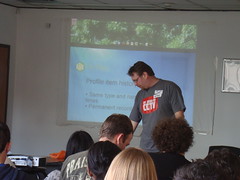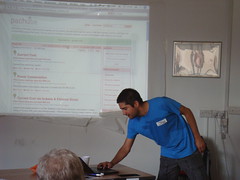Saturday 25th April saw the return of HomeCamp. HomeCamp started last year as the brainchild of Chris Dalby, aiming to bring together a growing community of people interested in “green” hacking and technologies.
I’ve had this post sat in draft for weeks now, meaning to come back and turn them into proper notes. As it’s been a few weeks now and I still haven’t, I thought I might as well post my rough notes as I took them on the day. Apologies that they’re a little sketchy!
- kicked things off talking about the idea of HomeCamp
- “taking back ownership of your own energy usage data and doing stuff with it”
 Martin Dix from CurrentCost:
Martin Dix from CurrentCost:
- talked about the digital boards he was contributing to HomeCamp hackers
- extending CurrentCost meter into other uses beyond energy monitoring?
- extending it beyond localised events – using with remote sensors?
- what information could be collected by the CC128 from sensors?
- example – Bharat connected it to gas meter, using digital output of recording the pulses from a pulse meter
- water could be done in a similar way?
- or outside temperature? or oil tank level? or something else?
- some debate around difficulties some developers having around using arduino with the CC128 – as it spits out data too fast
- should it support different modes? e.g. slower connection for live data only without bulk of history data
- should it support a duplex connection? e.g. some handshake where apps connect and negotiate what they want
- over 500,000 CurrentCost meters sold
- should CurrentCost host their own servers to collect (and analyse, compare, visualise etc.) the data?
- or should they partner with other people better suited to creating this
- similar to Wattson community site?
 Joe Baguley talking about energy monitoring (sans CurrentCost!):
Joe Baguley talking about energy monitoring (sans CurrentCost!):
- talked about Green Energy Options – who are currently doing a trial with UEA
- paid 250 quid (?) to join trial – electrician + technical guy spent several hours in his house instaling kit
- they open up consumer unit, and put mini clamps on each circuit going into consumer unit
- you get six individual appliance monitors
- monitors the power usage for a single plug
- each has a switch on top, to enable X10-like ability to turn on and off remotely
- also includes temperature sensor
- system supports up to 100 individual devices
- they give you an EEE PC netbook, modified to run WinXP Home with MySQL, Apache etc.
- (interestingly, to avoid you doing anything to it, they remove the keyboard!)
- uses communication over power-lines and zigbee
- USB device to collect data – acts as store-forward unit, so will collect data if EEE PC shut down
- Web-based interface hosted by the EEE PC
- some nice approaches to visualising the data
- each circuit identified (e.g. “lighting”)
- individual appliances identified
- realtime graphs – bar graphs, little animated avatars, speedos, scores & rewards, etc.
- includes ability to turn stuff off from the web interface
- can support gas – by clamping stuff to pipes – they don’t use the RJ45 on newer meters
Steve Lamb kicked off a session on Gas monitoring:

- Ken from Onzo reminded us of some of the “rules” regarding gas monitoring:
- nothing that sparks
- nothing that can heat up if two points fail
- battery powered therefore a must – nothing that is connected to the mains power
- wires near gas pipes = bad
- issues:
- wide variety in gas meter models and ages (Ken aware of at least 75 types in use)
- some meters have RJ11 – contacts which close every x cubic metres of gas
- optical readers an option, as discussed last time.
- some meters that are set up to make this easy called “opto ready” (?)
- neat idea from James Smith for monitoring optical data sources – using optical mouse + arduino – very cheap repurposing of hardware
 Jamie Andrews and James Smith from AMEE:
Jamie Andrews and James Smith from AMEE:
- AMEE:
- “making sense of energy and carbon”
- neutral aggregation platform for energy and carbon data
- provided back end for “Act on CO2″‘s Carbon Calculator
- approaches to profiling energy consumption for a domestic building
- estimated energy performance – sort of SAP thing you get from the energy certificate when you move house
- behavioural surveys – number of people, what appliances, what you try and do to save energy, etc.
- empirical data – CurrentCost readings etc.
- demand response
- “not all electricity is equal” – need to take realtime demand and cost into account when considering energy usage
- AMEE API
- “Fire Eagle for energy data”
- focusing on:
- Open Source
- Open & Linked Data
- Flexible charging structure
- two main sections:
- data : data items that represent classes of energy usage – e.g. data items containing fuel consumption data for each model of car
- profiles : submitted data for a person, building, or other entity – in consistent hierarchy to ‘data’
- RESTful api
- JSON and ATOM
- sample code in Java and Ruby
- offers:
- data warehousing
- standardised analytics
- decoupling
- so you can: publish your data from multiple sources, sensors and devices, all into AMEE
- AMEE 2 now live, many improvements, including:
- improved time resolution
- now time stamped to the minute (rather than month) and allows precise start/end times
- built-in unit conversion
- ATOM support for mashups (e.g. with Yahoo! Pipes)
- simpler authentication
- improved time resolution
- AMEE 3?
- realtime carbon intensity data
- data crowdsourcing?
- profile portability?
- demonstrated the pachube viz application which lets you output a pachube feed through Google visualisation
- the time-based graph used in google finance
- I blogged about it here
Tom Rafftery gave an inspiring talk on “electricity 2.0”
- my notes really can’t do it justice – but you can see a video of it which is definitely worth a watch
- slides are also on slideshare
- which even include some of my pics 🙂
Tags: barcamp, currentcost, energy, homecamp, pachube, smart metering

[…] is the boiler, so a simple on/off signal should be good enough to work out what I’m using. Dale’s recent roundup of HomeCamp 2 has some tantalizing hints of gas monitoring as well. (22 May 2009) Possibly related posts: […]